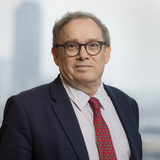What Turning a Blind Eye to Deviant Behavior Is Doing to London
The city’s mayor, Sadiq Khan, needs to take growing disorder on the streets more seriously.
Graffiti covers part of a train carriage on the Bakerloo Line on June 16, 2025, in London, England.
Photographer: Carl Court/Getty Images EuropeEvery day London becomes a bit more disorderly. The police report that shoplifting increased by more than 50% last year, a far sharper increase than in other regions, and thefts such as pickpocketing increased by 41%, with mobile phones plucked like low-hanging fruit. Transport for London (TfL) calculates that fare dodging costs the transit system £400 million ($540 million) a year, but the real figure may be much higher.
But these crime figures only capture a small proportion of the disorder. Delivery drivers cycle at high speed, often on the pavement, frequently scattering pedestrians in their path. The bikes have electric motors and thick tires; the drivers usually wear masks or balaclavas to conceal their faces, regardless of the heat. The sickly sweet smell of marijuana is ubiquitous in large parts of London (and certainly in Clapham where I live).
